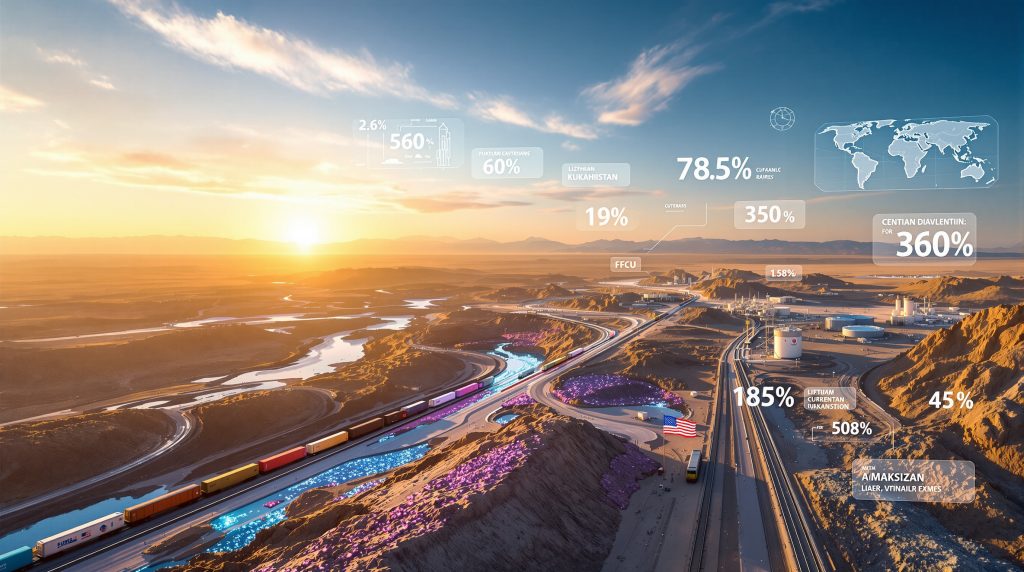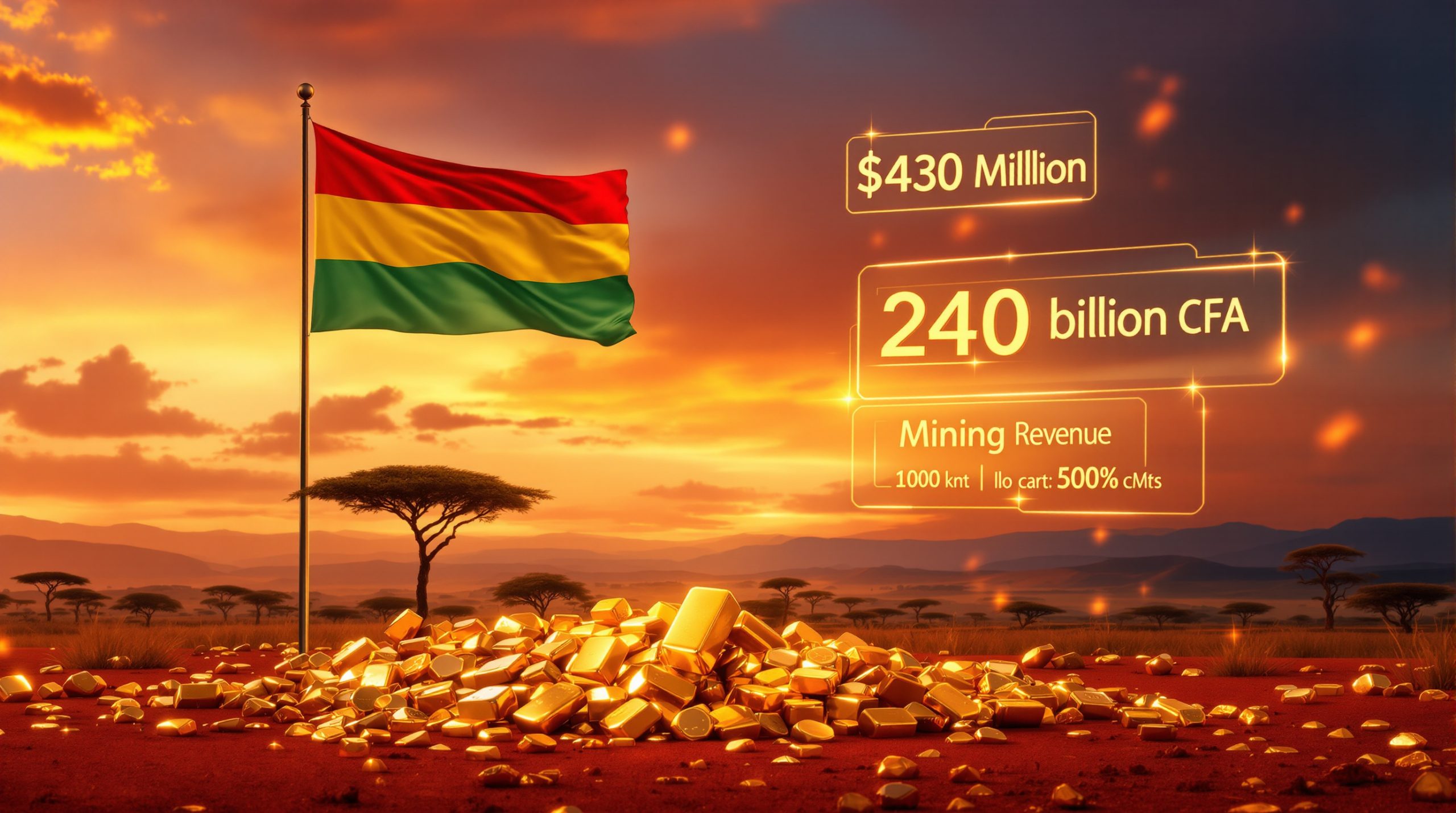Unlocking Central Asia's Mineral Resources Through Strategic Partnership
The Trump administration's renewed focus on Central Asian mineral resources reflects growing urgency around supply chain diversification as Washington seeks alternatives to Chinese-dominated critical material flows. U.S. rare earth diplomacy Central Asia initiatives represent a strategic pivot towards Kazakhstan, Uzbekistan, and Kyrgyzstan, nations that possess substantial tungsten, copper, and rare earth deposits that remain largely underdeveloped by Western companies. Furthermore, these uranium market dynamics create opportunities for strategic partnerships that could reshape global mineral markets.
Central Asia's Geographic Positioning and Resource Abundance
Central Asia's position as the Eurasian heartland provides unique advantages for diversifying global supply chains beyond traditional maritime routes. The region contains significant deposits of strategic minerals that Western extraction technologies could unlock through modernised mining operations.
Critical Resource Statistics:
• Kazakhstan holds approximately 2.6 million metric tonnes of rare earth reserves according to USGS data
• The region produces 40-41% of global uranium output, primarily from Kazakhstan's operations
• Substantial copper belt formations span multiple republics with proven reserves exceeding 30 million metric tonnes in Kazakhstan alone
• Unexplored lithium deposits offer potential for battery supply chain development, though comprehensive reserve estimates remain limited
The distinction between rare earth elements and broader critical minerals categories affects policy implementation across the region. REEs encompass 17 specific elements including lanthanides, scandium, and yttrium, while critical minerals and energy security include copper, lithium, cobalt, and tungsten within expanded classifications.
Kazakhstan's Balkhash copper belt contains geologically stable formations suitable for modern extraction methodologies, with ore grades supporting economically viable operations at current commodity pricing. However, many deposits require substantial capital investment in processing infrastructure to achieve commercial production levels.
The C5+1 Diplomatic Framework for Mineral Partnerships
The C5+1 platform represents Washington's primary multilateral engagement mechanism with Kazakhstan, Uzbekistan, Kyrgyzstan, Tajikistan, and Turkmenistan. This diplomatic structure enables coordinated resource partnerships while addressing individual nations' development priorities through technology transfer and infrastructure investment programmes.
Recent C5+1 summits have increasingly emphasised trade facilitation and investment cooperation, though critical minerals discussions remain peripheral to broader security and counterterrorism agendas. The September 2023 Washington summit included all five Central Asian nations, demonstrating sustained diplomatic engagement across the region.
Framework Priorities Include:
• Technology transfer agreements for mining modernisation and digital infrastructure development
• Infrastructure financing through development finance institutions
• Trade route optimisation via Middle Corridor development
• Regulatory harmonisation supporting transparent investment frameworks
Strategic Minerals-for-Technology Exchange Models
American policymakers envision reciprocal relationships where Central Asian nations provide mineral access in exchange for advanced technologies, capital investment, and market integration opportunities. This approach contrasts with debt-for-resource models by emphasising equity partnerships that preserve host nation sovereignty over natural resources.
Exchange Components Include:
• Mining equipment and extraction technologies for enhanced recovery rates
• Processing facility development creating local value addition
• Digital infrastructure upgrades supporting geological surveys and environmental monitoring
• Educational and technical training programmes building local capacity
The equity partnership structure typically involves joint venture formations with local ownership stakes, profit-sharing mechanisms, and technology licensing rather than equipment transfers. Moreover, management structures include host-nation representation to ensure development priorities alignment.
"The United States seeks to create sustainable partnerships that serve both American security interests and Central Asian development goals through patient capital deployment and governance support."
However, comprehensive minerals-for-technology agreements remain largely theoretical, with limited documentation of specific investment commitments or contractual frameworks currently in operation across Central Asian republics.
Geographic and Political Obstacles to Western Engagement
Central Asia's landlocked geography creates fundamental transportation bottlenecks that complicate mineral export strategies beyond regional markets. The incomplete Middle Corridor trade route across the Caspian Sea represents a critical infrastructure gap limiting commercial viability for large-scale operations.
Transportation and Infrastructure Constraints:
• Soviet-era rail networks with limited capacity for increased mineral transport volumes
• The Middle Corridor currently handles 3-5 million metric tonnes annually with projected capacity of 20-30 million metric tonnes at full development
• Seasonal energy shortages affecting electricity-intensive mining operations, particularly in Tajikistan and Kyrgyzstan
• Cross-border regulatory complexities creating customs and transit delays
Caspian Sea port access remains dependent on Azerbaijani cooperation, creating geopolitical vulnerabilities for mineral exports targeting European markets. Energy supply inconsistencies, particularly winter hydroelectric deficits, constrain year-round mining operations across multiple republics.
Governance and Political Economy Barriers
Elite networks within Central Asian governments often control mining concession access through opaque processes that favour established relationships over competitive bidding systems familiar to Western investors.
Transparency International's 2024 Corruption Perceptions Index reveals significant governance challenges:
| Country | CPI Score (out of 100) | Governance Risk Level |
|---|---|---|
| Kazakhstan | 36 | High corruption concerns |
| Uzbekistan | 30 | Significant transparency issues |
| Kyrgyzstan | 31 | Elevated governance risks |
These governance indicators contrast sharply with developed economies averaging 75+ scores, creating uncertainty for Western investors accustomed to transparent regulatory frameworks.
Resource nationalism trends have emerged across several republics, with Tajikistan implementing 51% state ownership requirements for major mineral extraction projects. Political succession uncertainties create policy continuity concerns affecting long-term investment planning.
China's Expanding Strategic Presence Through Infrastructure Investment
Beijing's systematic infrastructure investments through the Belt and Road Initiative have created integrated logistics networks directly connecting Central Asian resources to Chinese manufacturing centres. This decade-long development provides China with structural advantages over competing nations seeking mineral access.
Chinese Strategic Infrastructure Assets:
• Railway networks linking western China to Central Asia handling 150-200 million metric tonnes annually of freight
• Processing facilities enabling local value addition under Chinese technical supervision
• Financial institutions providing project funding through state-backed development banks
• Technical expertise for complex mining operations and downstream processing
According to World Bank data, China has invested approximately $62-85 billion in Central Asian infrastructure since 2008, distributed across railway projects, pipeline infrastructure, port facilities, and industrial zones. The Kazakhstan-China rail corridor, with completed rail gauge standardisation, serves as a critical freight artery for mineral exports.
State-Backed Corporate Expansion
Chinese state-owned enterprises continue expanding their Central Asian footprint through strategic acquisitions and joint ventures securing upstream control over critical mineral supplies. Recent investment activity focuses on copper, rare earths, lithium, and uranium projects through debt-for-resource and build-operate-transfer arrangements.
China Nonferrous Metal Mining Group operates multiple joint ventures in Kazakhstan's Balkhash copper belt region, including partnerships with Kazakhmys for copper and molybdenum production. Furthermore, CITIC Resources has expanded operations into Uzbekistan's emerging lithium fields, while CNPC maintains significant pipeline infrastructure investments across the region.
These projects serve Beijing's strategic objective of diversifying away from maritime chokepoints while securing upstream mineral inputs for domestic manufacturing industries. Chinese firms position themselves as infrastructural gatekeepers of Eurasian resource flows through integrated logistics and processing networks.
Infrastructure Development Requirements for Commercial Viability
Successful Western engagement in Central Asian mineral markets requires substantial infrastructure investments to overcome geographic constraints and enable competitive transportation costs to global markets.
Middle Corridor Completion Necessities:
• Caspian Sea port expansion increasing capacity for mineral exports
• Rail electrification projects improving freight efficiency and capacity
• Border crossing modernisation reducing transit delays
• Digital customs systems facilitating trade documentation
The Trans-Caspian trade route requires coordinated investment across multiple nations to become commercially viable for large-scale mineral exports. Current bottlenecks include limited port capacity in Azerbaijan, incomplete rail connections through Georgia, and energy supply inconsistencies affecting operations.
Processing Facility Development
Establishing regional processing capabilities would add value to raw mineral exports while creating local employment opportunities aligned with Central Asian development priorities. This approach supports U.S. supply chain resilience by reducing dependence on Chinese processing facilities.
In-region processing facilities require substantial capital investment in modern equipment, environmental monitoring systems, and technical workforce development. These investments could enhance mineral recovery rates while meeting international environmental standards increasingly required for Western market access.
Political Dynamics Affecting International Partnerships
Understanding elite network influence over resource access remains essential for structuring successful international partnerships. Political elites in Kazakhstan and Uzbekistan maintain significant control over mining concession allocation through informal networks paralleling formal governance structures.
This pattern reflects post-Soviet institutional legacies where business and government relationships create opaque decision-making processes. Western companies must navigate complex relationships between government officials, business leaders, and international investors to secure operational permits.
Governance Standards Implementation
Promoting transparency and accountability in mining sector governance serves both Western strategic interests and Central Asian development objectives. Technical assistance programmes can support regulatory capacity building while establishing international best practices for environmental monitoring and community engagement.
In addition, governance improvements require sustained commitment transcending political cycles, with patient capital deployment supporting institutional development alongside infrastructure investment. Success depends on balancing Western transparency standards with respect for Central Asian sovereignty and development priorities.
The Trump's critical minerals order demonstrates Washington's renewed focus on securing alternative supply chains through strategic partnerships with resource-rich regions.
Strategic Implications for Global Supply Chain Resilience
Successful U.S. rare earth diplomacy Central Asia could significantly reduce American dependence on Chinese mineral supplies while creating alternative pathways for critical material access. Supply chain diversification through Central Asian partnerships enhances national security resilience against potential export restrictions or geopolitical disruptions.
Regional Balance of Power Considerations
American economic engagement may provide Central Asian nations with greater leverage in relationships with Russia and China, potentially reshaping regional geopolitical dynamics over extended timelines. Enhanced Western presence could create competitive pressures encouraging improved terms from traditional regional partners.
However, success requires recognition that mineral diplomacy operates within broader geopolitical contexts where energy dependencies, security relationships, and historical ties influence decision-making beyond purely economic considerations. The US-Central Asia partnerships have evolved over the past decade, creating frameworks for enhanced cooperation across multiple sectors.
Competitive Advantages Despite China's Infrastructure Lead
Despite China's substantial infrastructure investments, the United States offers distinct value propositions appealing to Central Asian development aspirations through advanced mining technologies, transparent governance frameworks, and global market integration opportunities.
U.S. Competitive Strengths Include:
• Cutting-edge mining technologies improving extraction efficiency and environmental performance
• Environmental best practices meeting international sustainability standards
• Rule-of-law business frameworks reducing political risk for all participants
• Global market integration providing access to diverse export destinations
Western mining companies bring technical expertise in complex geological formations, advanced processing methodologies, and environmental remediation technologies that create value beyond initial capital investment. These capabilities align with Central Asian objectives for sustainable resource development supporting long-term economic growth.
Timeline and Investment Realities
Achieving meaningful supply chain diversification through Central Asian partnerships requires sustained commitment over multiple decades, substantial capital deployment, and patient relationship building transcending political cycles. Realistic expectations acknowledge that infrastructure development and institutional capacity building operate on extended timelines.
Investment requirements likely exceed tens of billions of dollars across transportation infrastructure, processing facilities, and governance capacity building programmes. Private sector participation depends on transparent regulatory frameworks and predictable returns supporting long-term capital commitments.
Measuring Success in Central Asian Mineral Partnerships
Effective U.S. rare earth diplomacy Central Asia would result in diversified critical mineral supply chains, strengthened bilateral relationships, and enhanced regional stability through sustainable economic development programmes.
Success Metrics and Benchmarks:
• Percentage of U.S. rare earth imports sourced from Central Asian operations
• Number of operational joint ventures between American and Central Asian partners
• Infrastructure project completion rates supporting mineral transportation
• Trade volume growth trajectories demonstrating commercial viability
• Governance improvements measured through international transparency indices
Comprehensive risk management frameworks must address political, economic, and operational challenges potentially disrupting mineral partnership development. Consequently, contingency planning should account for political transitions, commodity price volatility, and geopolitical tensions affecting regional stability.
Navigating Opportunity Within Complex Realities
Central Asia represents both significant opportunity and substantial challenge for U.S. rare earth diplomacy Central Asia seeking alternatives to Chinese-dominated supply chains. The region's mineral wealth offers pathways to supply diversification, yet success demands realistic assessment of infrastructure constraints, governance challenges, and competitive dynamics.
American policymakers must balance strategic ambitions with operational realities to build sustainable partnerships serving both U.S. security interests and Central Asian development goals. Patient capital, advanced technologies, and governance support can create competitive advantages, but only through comprehensive engagement respecting Central Asian sovereignty and development priorities.
Furthermore, the interconnected nature of copper pricing insights demonstrates how Central Asian mineral developments could influence global commodity markets beyond rare earth elements.
Disclaimer: This analysis involves forecasts and speculation about future geopolitical and economic developments. Actual outcomes may vary significantly from projections discussed. Investment and policy decisions should consider comprehensive risk assessments beyond information presented in this article.
The ultimate success of U.S. engagement in Central Asia depends on Washington's ability to provide sustained commitment, transparent partnership frameworks, and technological capabilities that create mutual value for all participants. Central Asia's critical minerals potential offers significant opportunities for diversifying global supply chains through strategic cooperation. Only through such patient diplomacy can America effectively compete with China's established presence while building lasting relationships across this strategically vital region.
Want to Profit from Critical Minerals Discoveries Before Global Markets React?
Whilst Central Asia offers long-term strategic opportunities for critical minerals diversification, savvy investors can capitalise on immediate discoveries closer to home through Discovery Alert's proprietary Discovery IQ model, which provides real-time alerts on significant ASX mineral discoveries including rare earths, copper, and lithium announcements. Begin your 30-day free trial today and position yourself ahead of the market with actionable insights that turn complex mineral data into profitable opportunities.




